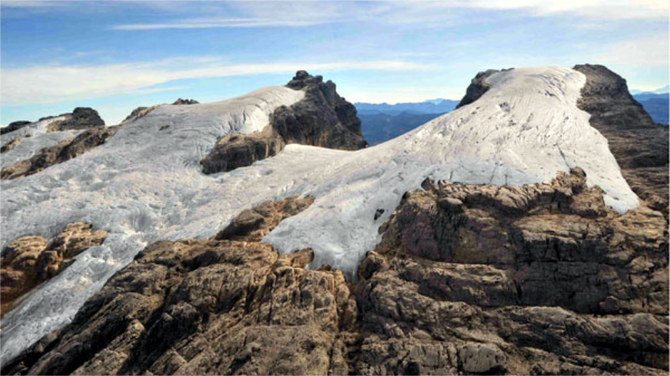JAKARTA: Indonesia’s little-known glacier may disappear as early as 2025, the Meteorological, Climatology, and Geophysics Agency BMKG said on Sunday, with rising temperatures having accelerated the melting of the ice.
The tropical glacier, one of a handful left in the world, lies on a mountain near Puncak Jaya in Indonesia’s easternmost province of Papua. It has undergone a rapid loss of ice coverage and thickness in the past two decades that could lead to the snow completely disappearing in just a few years’ time.
The Papuan glacier is remnant of glaciers that have existed for around 5,000 years, researchers said. It is one of the few remaining tropical glaciers, with others located in South America and Africa.
Dodo Gunawan, who heads BMKG’s climate change department, told Arab News: “The snow on Puncak Jaya will vanish soon. This is happening because of global warming.”
“Because temperatures at the peak have already increased, it can no longer sustain the snow to compact down into the glacier.”
Though the glacier has been melting for years, increasing global temperatures and reduced rainfall that has been exacerbated by El Nino — a phenomenon that causes tropical ocean water and atmospheric temperatures to get warmer — has sped up the thinning of the glacier.
Donaldi Permana, the agency’s deputy director climate and air quality research, said around the beginning of the industrial revolution, in 1850, the total glacier area on the Puncak Jaya mountain range was estimated at around 20 sq km. By 2002, ice coverage in the area had decreased to around 2 sq km, and was recorded at 0.34 sq km by May 2020.
The thickness of the glacier has been greatly reduced since 2010, when it was at 32 meters, to 22 meters in 2016. The ice thinned to around 8 meters by 2021.
“Under these conditions, between 2025 and 2027, it is likely that the ice will vanish,” Permana told Arab News.
Tropical glaciers are highly sensitive indicators and recorders of climate change, according to the World Meteorological Organization.
The disappearance of the snow-capped peaks in Papua would not only mean the loss of a rare site for Indonesia, but might also affect the fauna and flora in the area, an aspect that Permana said researchers still need to explore further.
It will also be a huge cultural loss for the local Papuan community.
“Culturally, there are native tribes around Puncak Jaya who consider the glacier as a sacred site. The ice’s disappearance will have an impact on them,” Permana said.















